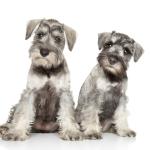Miniature Schnauzer

The miniature schnauzer or zwergschnauzer is a small, cheerful, loyal and bearded dog. Although its size does not exceed 35 centimeters it is a very brave and dynamic dog. It is the miniature version of the schnauzer.
- Europe
- Germany
- 5-14
- 14-18
- 18-22
- 22-27
- 27-31
- More than 31
- 2-7
- 7-22
- 22-55
- 55-100
- 100-220
- Low
- Meidum
- High
Physical appearance
This is a small, elegant, compact, robust dog with a square profile. It face is highlighted by the dense eyebrows above its eyes and its thick beard.
The back of a miniature schnauzer is strong and short, and their upper line descends slightly from the cross. Its rump is slightly rounded. Its chest is moderately wide, but deep. Its belly is slightly picked up.
The head of a miniature schnauzer dog is rectangular, strong and elongated, presenting a well defined naso-frontal depression. Its nose is black and its snout has a truncated wedge shape. It has a strong scissor bite.
Its eyes are medium, oval and oriented towards the front. They have a happy and vivacious expression. Its "V" shaped ears bend and fall forward, resting on the inner edges of its cheeks. Their ears were formerly cut to keep them erect, but thankfully nowadays that custom is banned.
The tail of the miniature schnauzer is shaped like a saber or sickle. This tail was formerly amputated and nowadays unfortunately this tradition still takes place is some countries. However the FCI standard of this breed demand natural tails.
Its coat is made up of two layers. The inner layer is formed by a dense fleece, while the outer layer is formed by hard, rough hairs well attached to its body. Accepted colors for this breed are:
- Pure black with black inner fleece.
- Salt and pepper.
- Black and silver.
- Pure white with white inner fleece.
Behavior and Character
Schnauzers are very active, intelligent, curious and loyal. They learn easily and quickly and when they are treated well they are very gentle with their family. They are also intrepid and perseverant animals.
They tend to have strong character so it is important to take their socialization seriously from an early age. This will avoid them from being aggressive or fearful dogs when they are older. Correct socialization will also facilitates the interaction between adult miniature schnauzers and people.
Because they learn easily, their canine training is simple and fun. However, dogs must be educated through positive training styles, since traditional training does not provide very good results, specifically with this breed.
Dog obedience training does not directly address many aggression problems but it helps a lot as it teaches the dog to have more confidence and self-control.
These dogs are barkers. This can be an advantage if you want a companion dog that also serves as a guardian dog. However, it can be a serious problem when you live in an apartment.
In general, miniature schnauzers are great pets for young people, adults and seniors. They are intelligent, gentle and great companions. However, they do not respond well to rough treatment, so they are not the best option for young children.
Weight and Height
The height range for this breed, whether a male or female, ranges from 30 to 35 centimeters. The ideal weight for a miniature schnauzer ranges between 4 and 8 kilograms.
Helath and Care
Like many other dog breeds, the miniature schnauzer is prone to some canine diseases, such as;
- Cataracts
- progressive retinal atrophy
- Liver problems
- reactions to vaccines
- diabetes
- pancreatitis
- gallstones
- von Willebrand's disease
- heart murmur
- allergies
- obesity
Its coat requires brushing every other day and the occasional bath when it gets dirty. It is also necessary to cut its hair about four times a year, which is best done in a canine hairdresser. This breed does not shed hair, making it ideal for people who suffer from allergies but who still want to have a dog.
Although they are small, the miniature schnauzer need a good dose of daily exercise. In order to maintain the good physical condition of this dog it needs to be walked a couple times a day with some daily play time.
This dog also needs frequent company. They are not able to stay alone for long periods of time. They live better indoors and adapt very well to life in an apartment, although it is necessary that they receive enough exercise.
History of the Miniature Schnauzer
The miniature schnauzer originated in Frankfurt, Germany. Although there is no absolute certainty of the crosses made to achieve this current breed, it is believed that they derive from the affenpinscher and the miniature poodle.
They were originally used as ratters and guard dogs on farms. Little by little however their beautiful appearance and pleasant personality gained the sympathy of its people and today, the miniature schnauzer is an extremely popular companion dog all over the world.
Miniature Schnauzer photos






